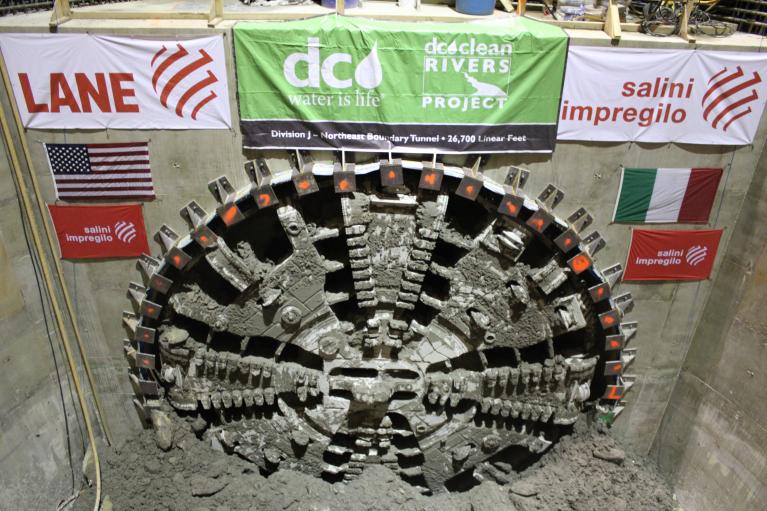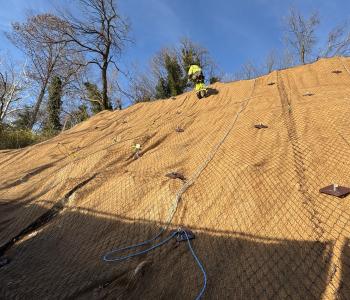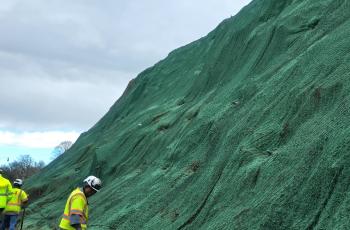DC Water’s Tunnel Boring Machine breaks through concrete shaft to reach key milestone

Contractor to make repairs on the TBM for its final push
DC Water’s giant tunnel boring machine, named Chris, broke through a wall of concrete to reach the W Street shaft, a key milestone in the mining of the Northeast Boundary Tunnel (NEBT). Chris will rest for a bit in the shaft and get much-needed maintenance before resuming work.
Excavating through clay and sand, Chris the machine is on a five-mile-long underground journey digging the NEBT which is the last tunnel segment of the Anacostia River Tunnel. This is actually a giant 23-foot-diameter sewage tunnel that can store 90-million gallons of combined sewage during heavy rains to keep from overflowing the combined sewer system in the District. The combined sewage will ultimately make its way to the Blue Plains Advanced Wastewater Treatment Plant where it will be treated, cleaned and recycled back to the Potomac River.
When Chris finishes mining and all work is complete in 2023, the Northeast Boundary Tunnel will connect to the existing First Street Tunnel. The first half of the tunnel opened in March 2018 and has already substantially improved the health of the Anacostia River.
"To date, the portion of the Anacostia River Tunnel that is in service has prevented more than 7 billion gallons of combined sewage and 3,500 tons of trash from entering the Anacostia, bringing a resurgence to the waterfront. The Northeast Boundary Tunnel in particular will significantly reduce sewer backups and chronic flooding in the Bloomingdale and LeDroit Park and other neighborhoods adjacent to Rhode Island Ave, NE,” said David L. Gadis, CEO and General Manager of DC Water. When the entire 13.1 mile Anacostia River Tunnel, is completed, it will reduce combined sewer overflows to that river by 98 percent.
The boring machine has been mining since September of 2018 and the tools on its cutterhead are worn from all the work. The construction contractor Salini Impregilo Healy (Lane Construction) Joint Venture will use the shaft to park the TBM while replacing rippers, knives, and disc cutters on its face and performing other maintenance. The TBM is scheduled to resume the final 11,000 feet in early May. Already, Chris has tunneled more than 15,600 feet (2.95 miles).
Working 24 hours per day, five days a week, Chris excavates about 4 inches per minute. Twelve to 15 people per shift support the TBM operation. Every six feet Chris stops to install a portion of the permanent tunnel liner, called a “ring.” Each ring is made up of seven interlocking concrete segments. Once a ring is completed the TBM pushes forward to excavate another six feet before installing the next ring. Approximately 4500 rings will form the tunnel liner. The concrete segments, each weighing 14000 pounds, are manufactured in Maryland, hauled to the construction site and lowered to the TBM.
"We have an amazing group of professionals and hard workers on this project, and we are proud to be partnering with DC Water on this historic endeavor,” said Daniele Nebbia, Director of Tunneling for Salini Impregilo Healy (Lane Construction) Joint Venture.
In the tunneling industry, much like with ships, TBM’s are ceremoniously given a name. This TBM was named after DC Water’s own Christopher Allen, the Assistant Director for the Clean Rivers Project who passed away in 2017. Mr. Allen had 47 years of experience in construction management, field supervision and program management of large buildings, mass transit, heavy construction projects and aviation programs. This successful breakthrough would make Chris Allen very proud.








